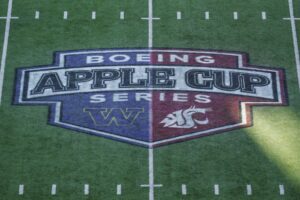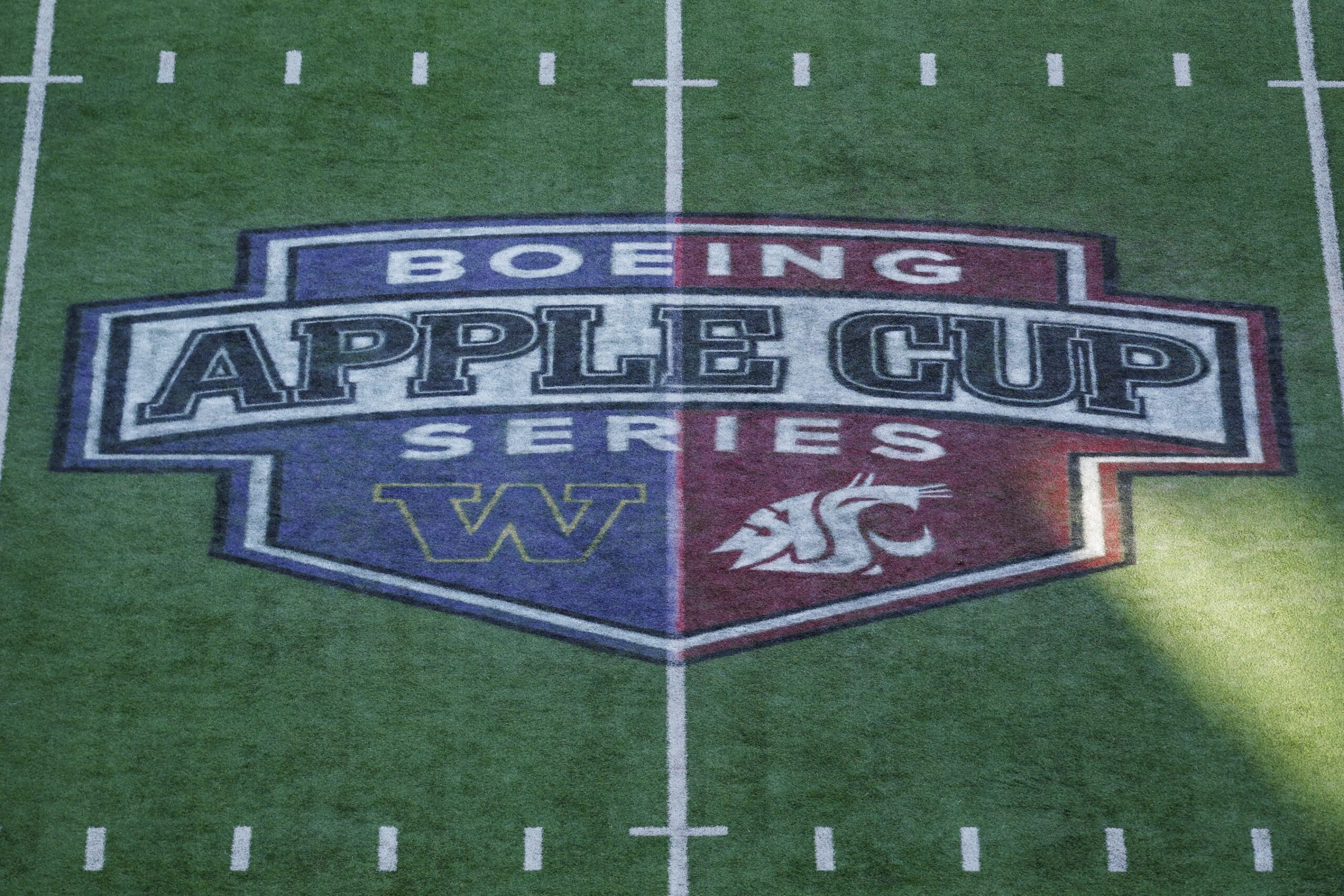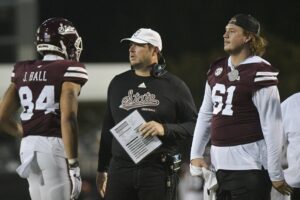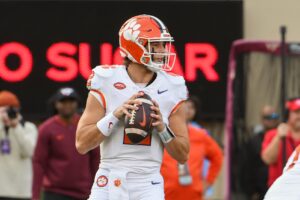“There are no pro football rivalries even close to college football rivalries.” Jedd Fisch understands the weight of these games in college football. “It is the greatest thing in football,” Fisch added. He’s coached in several rivalry games including The Game, the Territorial Cup, and now the Apple Cup. This year’s Apple Cup is the first time since 1948 that the state’s storied rivalry won’t be played in November. It’s the first-ever meeting between Washington and Washington State in September. Lumen Field is the site for Saturday’s Apple Cup, and the two will meet as non-conference rivals. Fisch said Washington is treating it like a regular home game, staying at the same hotel, using the same busses, and arriving at the same time. It might sound like business as usual, but this one is different.
Preparing for Dual-Threat
Through two games this season, Washington State has scored 107 points and tallied north of 1,000 yards. Quarterback John Mateer was responsible for eight touchdowns in those two games. The redshirt sophomore has emerged as one of the more electrifying players in college football in the young season. In game one, it was a 350-yard passing performance with five touchdowns through the air and another on the ground. His six total touchdowns in week one were a school record. He followed that up with a 197-yard showing on the ground last week against Texas Tech.
“The dual-threat is a real deal, it makes it challenging,” Fisch said in his weekly presser. “You are going against an elite dual-threat quarterback that has the ability to run and pass at a very high level.” In two games, Mateer showed exactly that. When the passing game was there, he exploited it against Portland State. Against Texas Tech, the pass wasn’t clicking, and Mateer carried the offense with his feet.
But Washington has a dual-threat quarterback on its roster in Demond Williams Jr. At practice, Fisch said they spend 85% of their practice time with the whole team on one field which produces a lot of “good-on-good” matchups. Williams has taken “a lot of the reps” with the first offense, according to Fisch. This has allowed Washington’s starting defense to get a good feel for a running quarterback. “It’s certainly helpful for our defense to be able to have gone all training camp going against somebody with Demond’s skillset.”
Washington State Run Offense
When you take a closer look at what the Cougars do well, they run the ball with a high success rate. In the team’s 21-point victory over Texas Tech, Washington State ran the ball 44 times. 20 of those runs gained four yards or more. Importantly, a lot of that rushing success came on early downs. Washington State went to the run on 65% of its early-down plays and had a 44% success rate in doing so. Success, in this case, is defined as gaining at least 50% of the yards to go on first down, and at least 70% of the yards to go on second down.
On first down specifically, Washington State ran the ball on 19 of its 28 attempts against Texas Tech. The Cougars gained an average of 6.5 yards per first downplay. This production on first down has been a critical factor in Washington State’s ability to use Mateer as a runner. Short yardage on second and third downs gives the offense options. It goes back to what Fisch said on Monday of this week in his press conference. Early down success is vitally important to sustaining drives and opening up the offense. That’s exactly what Washington State did in its week two matchup, and Mateer took advantage.
Mateer was the leading rusher for the team with 21 carries and 197 yards last Saturday. His success rate running the ball was 47% on those carries. It’s no wonder he averaged over 10 yards per carry. Of course, the sample set is small when considering just the one game against the Red Raiders. But the Cougars showed how dangerous they can be when the ball is in the hands of their playmaker at quarterback.
Difference-Making Matchup
Mateer’s escapability out of the backfield is going to be one of the major factors in Saturday’s contest. Washington has to maintain its discipline upfront this weekend. Containing Mateer begins with interior pressure on the defensive line. When you create good pressure in the middle, it obstructs vision lanes for the quarterback and takes away a clean pocket for the passer to step up into. EDGE defenders then need to set a hard edge and take away a scramble threat when that pocket collapses up front. The latter piece of this combination is essential for containing a mobile quarterback.
The direction this game swings is going to center around one key factor: Can Washington create quality interior pressure, and can it set an edge consistently? The Huskies rotated eleven defensive linemen in week one against Weber State and continued to cycle different players up front against Eastern Michigan. On the interior, Sebastian Valdez, Jayvon Parker, Elinneus Davis, and Jacob Bandes have been among the rotation. At EDGE, Washington has seen tremendous production from Zach Durfee who had 2.5 sacks last week. As well as Isaiah Ward, Deshawn Lynch, and Voi Tunuufi who has played on both the inside and outside.
“We’re able to substitute a lot of guys…You’ve got these guys playing a lot of different snaps inside and out, which has allowed us to be able to make some plays,” Fisch said. This is going to be the difference on Saturday. Washington has the bodies to rotate personnel up front. Each level of this rotation has been effective when on the field this season. Fresh players in the rotation who understand the importance of their assignments, and can hit their assignments will allow Washington the opportunity to slow down a dual-threat quarterback.
Where Washington Can Find Success
Washington running back Jonah Coleman put together back-to-back 100-plus yard rushing performances to begin the season. He came in for one play late in the fourth quarter against Eastern Michigan to reach that milestone for the second week in a row. On Saturday in the Apple Cup, Coleman and the Washington offense will have an opportunity on the ground.
Washington State ranks near the bottom in the FBS in rushing stuff rate, at just 15%. A stuffed run is when the ball carrier is stopped at or behind the line of scrimmage. The national average is 31%. The Cougars aren’t getting that push up front consistently. Even against Portland State in week one, their staff rate was just 21%, far below the national average.
Coleman ranks sixth nationally in yards after contact with 180 on the season. He averages 6.7 yards after contact per carry. With Washington State’s lack of push up front, Coleman is going to create positive yards on the ground every time he touches the football. When on offense, expect to see the Huskies use their run game to wear down the Cougar front.
Apple Cup Prediction
This game is likely going to come down to how well Washington can contain Mateer at quarterback. Of his 21 attempts last week, 15 of them were designed quarterback runs. Washington has to maintain its discipline up front on Saturday. It starts with that interior pressure and will be tested on the EDGE. If the Huskies can contain Mateer and force him to pass more often than he wants to, things could swing in Washington’s favor. But with an athlete like Washington State has under center, it’s hard to justify the Cougars not finding the end zone for the first time against this Husky defense all season.
Washington – 31
Washington State – 27







